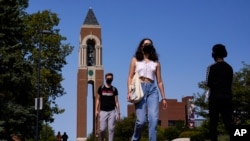While student debt and the affordability of a college education as a youth voter issue has been overshadowed by COVID and race events, it remains a top concern for many.
“I’ve been paying whatever the minimum is for well over a decade,” said Victor Varadi, senior program manager at Disney/ABC, to VOA. Now 47, he has been paying down more than $50,000 in student loans for his undergraduate and master’s degree studies since 2006. The interest rate on those loans have been between 5% and 7%, he said.
Varadi is among the student debtors who owe $1.5 trillion to lending institutions, more than all credit card debt in the U.S., according to Brookings Institution in an October report.
A third of that debt is owned by only 6% of borrowers. On the other end, 18% of borrowers owe less than $5,000 in student debt, according to the Brookings Institution last November.
“Clearly, solving the college debt problem involves not only making higher education more affordable, but also ensuring that students are on a sustainable path to pay off their debts,” stated McKinsey and Company, a management consulting firm, on its website.
In the spring, before the COVID-19 pandemic caused a widespread closure of college campuses, 85% percent of young Americans — 94% Democrat and 76% Republican — favored student debt loan reforms, according to the Institute of Politics at Harvard University’s Kennedy School of Government.
American colleges and universities are significantly more expensive today than when earlier generations attended. Between 1980 and 2014, the average annual increase in college tuition grew by nearly 260%, according to the Bureau of Labor Statistics.
"There was a time when a small amount of savings and a part-time job could get students through college with little or no debt," wrote Mary Clare Anselem, policy analyst for the Heritage Foundation's Center for Education Policy, as reported by VOA at the time. "But today, more students than ever are turning to federal loans to finance their college education."
President Donald Trump and Democratic candidate former Vice president Joe Biden have included the high cost of education and student debt into their platforms, offering different plans to resolve what has been a big issue for millennials. While paying off student loans, debtors are limited in buying homes and having children.
Below are the candidates’ platforms for higher education and student debt.
In “A Budget for America’s Future” for fiscal year 2021, Trump proposes:
- Loan limits
- Loan forgiveness
- Simplifying financial aid
- Increasing Pell grants
- Reducing unnecessary school costs
- Providing expedited loan forgiveness
- Safeguarding students from fake institutions
- Continued limits on programs for international students
The president’s budget would expedite “loan forgiveness for undergraduate borrowers who make 15 years of responsible payments,” it stated, and proposes “sensible annual and lifetime loan limits.” Undergraduate students can borrow from $5,500 to $12,500 a year, according to the Federal Student Aid website.
International students are not eligible for federal loans, and more than 60% pay out of pocket, according to the Institute for International Education (IIE). But they can borrow from private lenders who charge higher interest rates but offer larger loans.
Trump proposes o eliminating international educational programs since "a number of other federal agencies offer programs that are similar and potentially duplicative." The budget proposal did not specify which programs or agencies.
In September, the Department of Homeland Security (DHS) proposed a rule fixing student visas to four-year terms for international students and requiring them to apply for extensions. The rule would limit international student visas to a fixed two-year term for students from countries with a visa overstay rate above 10% or a country on the U.S. State Department’s State Sponsor of Terrorism list.
According to Biden’s website, joebiden.com, he proposes:
- Reducing student debt
- Investing in community college
- Increasing Pell grants
- Strengthening education as a pathway to the middle class
- Making financial aid available to DACA students
- Increasing quality and affordability
- More assistance for historically Black colleges and universities (HBCU)
Biden’s plan states he wants to invest in community colleges to give more students access to higher education. Community colleges are more flexible, less competitive and far less expensive than other schools. Some will accept and teach English to students who don’t have a command of the language yet, which is appealing to many international students.
Biden’s wife, Jill, holds a doctorate in education and teaches English at Northern Virginia Community College in Alexandria, Virginia.
The federal government would cover 75%, with states paying 25%, the candidate’s plan states. Students from American Indian tribes would receive additional assistance.
The two plans have some similarities. Biden and Trump say they want to help more students get Pell grants, which helped more than 7 million students with aid during the 2017-18 school year.
Pell grants were introduced in 1972. Named after Sen. Claiborne Pell of Rhode Island, they award undergraduate students aid based on financial need, and, unlike loans, do not have to be repaid.
Trump says he wants to expand the use of Pell grants to make them available to “certain incarcerated students to improve employment outcomes, reduce recidivism, and facilitate their successful reentry to society.” He did not specify which kind of incarcerated students would be given Pell grants.
Biden says he wants to see the program applied more broadly, proposing to “double the maximum value of the Pell grant, a level of investment experts say is necessary to close the gap between the rich and poor so that everyone has the opportunity to receive an education beyond high school,” his website asserts.









